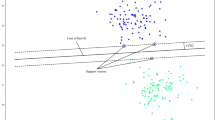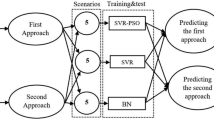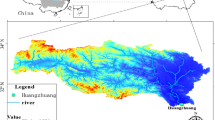Abstract
With the increase in extreme weather, cities, especially those with small- and medium-sized urban rivers with protected areas smaller than 200 square hectares, are experiencing significantly more flood disasters worldwide. Heavy snowfall and rainfall can rapidly overflow these rivers and cause floods due to the unique geographic locations and fast runoff and confluence speeds of the rivers. Therefore, it is particularly important to accurately predict the short- to medium-term water levels of these rivers to reduce and avoid urban floods. In the present work, a particle swarm optimization (PSO)-support vector machine (SVM) water-level prediction model was constructed by combining PSO and SVM and trained with meteorological data from Wuhan, China, and water-level data from the Yangtze River. The PSO-SVM model is able to lower the mean square error (MSE) of the prediction results by 70.47% and increase the coefficient of determination (R2) by 7.02% compared with the SVM model alone. The highly accurate PSO-SVM model can be used to predict river water levels in real time using hourly weather and water-level data, thereby providing quantitative data support for controlling urban floods, managing water project construction, improving response efficiency and reducing safety risks.









Similar content being viewed by others
References
Adamowski J, Chan HF (2011) A wavelet neural network conjunction model for groundwater level forecasting. J Hydrol 407:28–40
Anirudh V, Umes C Classification of rainy days using SVM. In: Proceedings of Symposium at HYDRO, Norfolk, Virginia, USA, 2007.
Barrameda KB, Lee SH, Kim S-Y (2018) Simulation of Flood Water Level Early Warning System Using Combination Forecasting Model. International Conference on Software Engineering Research, Management and Applications. Springer, pp 207–217
Cable Network (2019) Climate Change in 2019 Causes At least 15 Natural Disasters Worldwide. Sohu. https://www.sohu.com/a/363899409_249929. Accessed 23 June 2020
Caizhi S, Xueyu L (2003) Research on fuzzy Markov chain model with weights and its application in predicting the precipitation state. J Syst Eng 18:294–299
Eslamian S, Gohari S, Biabanaki M, Malekian R (2008) Estimation of monthly pan evaporation using artificial neural networks and support vector machines. J Appl Sci 8:3497–3502
Galavi H, Mirzaei M, Shul LT, Valizadeh N (2013) Klang River–level forecasting using ARIMA and ANFIS models. J Am Water Works As 105:E496–E506
Hin LZ, Othman Z (2020) Lake Chini Water Level Prediction Model using Classification Techniques. In: Computational Science and Technology. Springer, pp 215–226
Huang C-L, Dun J-F (2008) A distributed PSO–SVM hybrid system with feature selection and parameter optimization. Appl soft comput 8:1381–1391
Khan MS, Coulibaly P (2006) Bayesian neural network for rainfall-runoff modeling. Water Res Res. https://doi.org/10.1029/2005WR003971
Kia MB, Pirasteh S, Pradhan B, Mahmud AR, Sulaiman WNA, Moradi A (2012) An artificial neural network model for flood simulation using GIS: Johor River Basin. Malaysia Environ Earth Sci 67:251–264
Kisi O, Shiri J, Karimi S, Shamshirband S, Motamedi S, Petković D, Hashim R (2015) A survey of water level fluctuation predicting in Urmia Lake using support vector machine with firefly algorithm. Appl Math Comput 270:731–743
Kühn M, Schöne T (2017) Multivariate regression model from water level and production rate time series for the geothermal reservoir Waiwera (New Zealand). Energy Procedia 125:571–579
Lee G, Lee S, Park H (2013) Improving applicability of neuro-genetic algorithm to predict short-term water level: a case study. J Hydroinf 16:218–230
Lin Z, Levy JK, Xu X, Zhao S, Hartmann J (2005) Weather and seasonal climate prediction for flood planning in the Yangtze River Basin. Stoch Env Res Risk Assess 19:428–437
Moghaddamnia A, Ghafari M, Piri J, Han D (2009) Evaporation Estimation Using Support Vector Machines Technique International Journal of Engineering and Applied Sciences 5:415–423
Nkiaka E, Nawaz N, Lovett J (2018) Effect of single and multi-site calibration techniques on hydrological model performance, parameter estimation and predictive uncertainty: a case study in the Logone catchment Lake Chad Basin. Stochastic Environ Res Risk Assess 32:1665–1682
Qiao W, Yang Z, Kang Z, Pan Z (2020) Short-term natural gas consumption prediction based on Volterra adaptive filter and improved whale optimization algorithm. Eng Appl Artificial Intell 87:103323
Rao A, Upadhaya P, Pandey S, Poulose J (2019) Simulation of extreme water levels in response to tropical cyclones along the Indian coast: a climate change perspective. Natural Hazards 100(1):151–172
Selakov A, Cvijetinović D, Milović L, Mellon S, Bekut D (2014) Hybrid PSO–SVM method for short-term load forecasting during periods with significant temperature variations in city of Burbank. Appl Soft Comput 16:80–88
Shiri J, Shamshirband S, Kisi O, Karimi S, Bateni SM, Nezhad SHH, Hashemi A (2016) Prediction of Water-Level in the Urmia Lake Using the Extreme Learning Machine Approach Water Resources Management 30:5217–5229
Shrivastava NA, Khosravi A, Panigrahi BK (2015) Prediction interval estimation of electricity prices using PSO-tuned support vector machines. IEEE Trans Industr Inf 11:322–331
Simon B, Insa N, Lothar F (2018) Real-Time Water Level Prediction Based on Artificial Neural Networks. International Conference on Urban Drainage Modelling. Springer, pp 603–607
Tan X, Yu F, Zhao X (2019) Support vector machine algorithm for artificial intelligence optimization. Clust Comput 22:15015–15021
Wang J, Sui J, Guo L, Karney B, Jüpner R (2010) Forecast of water level and ice jam thickness using the back propagation neural network and support vector machine methods. Int J Environ Sci Technol 7:215–224
Wei C-C (2012) Wavelet kernel support vector machines forecasting techniques: Case study on water-level predictions during typhoons. Expert Syst Appl 39:5189–5199
Xie Z-t, ZHANG X-f, TAN G-m, YANG F-l (2005) Forecasting of stage-discharge relationship of Luoshan on the Yangtze River Journal of Wuhan University of Hydraulic and Electric Engineering:3
Yadav B, Eliza K (2017) A hybrid wavelet-support vector machine model for prediction of Lake water level fluctuations using hydro-meteorological data. Measurement 103:294–301
YAO Z, XU J-p, KONG J-l, LIU S-b (2018) Prediction of River Water Level by GA-Elman Model Journal of Yangtze River Scientific Research Institute:9
Yarar A, Onucyıldız M, Copty NK (2009) Modelling level change in lakes using neuro-fuzzy and artificial neural networks. J Hydrol 365:329–334
Zakaria ZA, Shabri A (2012) Streamflow forecasting at ungaged sites using support vector machines. Appl Math Sci 6:3003–3014
Zhang X, Guo X, Hu M (2016) Hydrological effect of typical low impact development approaches in a residential district. Nat Hazards 80:389–400
Zhao G, Pang B, Xu Z, Xu L (2019) A Hybrid Machine Learning Framework for Real-Time Water Level Prediction in High Sediment Load Reaches. J Hydrol 581:124422
Zhu X, Lu C, Wang R, Bai J (2005) Artificial neural network model for flood water level forecasting. J Hydraul Eng 36:806–811
Funding
The funding provided by National Natural Science Foundation of China (Grand Numbers 51778262 and 51978302).
Author information
Authors and Affiliations
Corresponding author
Additional information
Publisher's Note
Springer Nature remains neutral with regard to jurisdictional claims in published maps and institutional affiliations.
Supplementary Information
Below is the link to the electronic supplementary material.
Rights and permissions
About this article
Cite this article
Qin, Y., Lei, Y., Gong, X. et al. A model involving meteorological factors for short- to medium-term, water-level predictions of small- and medium-sized urban rivers. Nat Hazards 111, 725–739 (2022). https://doi.org/10.1007/s11069-021-05076-y
Received:
Accepted:
Published:
Issue Date:
DOI: https://doi.org/10.1007/s11069-021-05076-y




